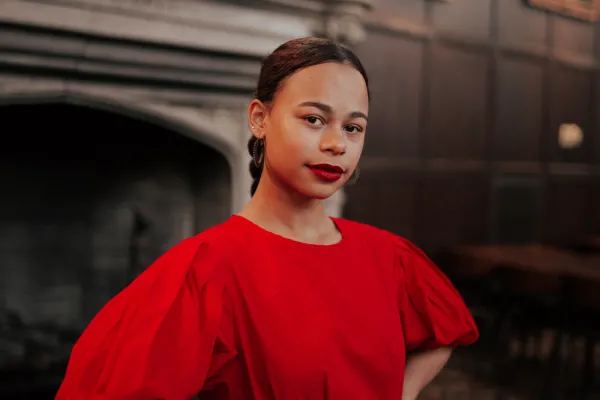Camille Bacon ’21: Smith’s Cromwell Fellow
Campus Life

Published June 15, 2020
The inspiration that led Camille Bacon ’21 to apply for Smith’s inaugural Cromwell Fellowship was sparked in January at an exhibition at the Smith College Museum of Art.
As soon as Bacon stepped through the gallery doors and began exploring the paintings, drawings and other works displayed in “Black Refractions: Highlights from the Studio Museum in Harlem,” she knew she had found her calling.
“I’ve always loved art, and my parents took me to lots of museums as a kid,” Bacon said, in a recent interview from her family’s home in Chicago. “But I’d never really seen myself reflected on the gallery walls.”
“Walking into the SCMA exhibition, I wasn’t expecting to have a life changing experience,” she added. “It turned out to be a clarifying moment where I realized, the art world is where I need to be.”
The exhibition of works by artists of African descent made her “deeply curious,” she said—not only about the art itself, but also about the role of the Studio Museum, where Thelma Golden ’87 is now director and chief curator.
Bacon, who is majoring in Africana studies, decided to apply for a Cromwell Fellowship to support research for an honors thesis about how art reflects and shapes understandings about race.
Funded by Smith President Kathleen McCartney, the Cromwell Fellowship was created last year to honor the legacies of two remarkable alums: Otelia Cromwell, a member of the class of 1900 and the college’s first African American graduate; and her niece, Adelaide Cromwell ’40, Smith’s first African American faculty member.
Since 1989, Smith has celebrated an annual Otelia Cromwell Day as a time of reflection and learning about racism and diversity. In 2019, after Adelaide Cromwell passed away, the event was renamed Cromwell Day and the fellowship was established by the Cromwell Day Committee to support one student per semester doing research on those topics.
With her award, Bacon is spending the summer researching landmark 1990s exhibitions featuring African American artists, and learning all she can about the work of the Studio Museum to help refine her ideas about what art can reveal about culture and race.
“I’m interested in how, when the work is by a black woman artist, critics will often focus more on their biographical information than just looking at the art,” she said. “I think that has a lot of do with how the American legacy of slavery mediates the way we look and see. It’s very difficult for people to see a black woman artist as just an artist; black women don’t have access to the same universality.”
Daphne Lamothe, associate professor of Africana studies, said Bacon’s proposal “perfectly exemplified” the type of independent research in black studies that the Cromwell Fellowship was designed to support.
“We were impressed by her project’s ambitions,” said Lamothe, who led the fellowship selection committee. “Camille’s research has the potential to galvanize new ideas and insights about race, culture and identity. And her move to exploring visual culture and museum studies will build on her already very solid background in cultural studies.”
For Bacon—who came to Smith planning to study pre-medical sciences—the fellowship award has bolstered her emerging passion for art history.
“I’ve learned a lot about myself in this process,” she said. “I wasn’t sure what research meant until I found a topic I really love. Maybe the biggest lesson I’ve learned so far is to take the pressure off of myself and not hinder my own curiosity.”
What’s it like to be doing research in the context of a global pandemic and nationwide Black Lives Matter protests?
“It’s difficult to be a black woman and watch my city burn while doing this work,” Bacon said. “But we’re seeing that one way people are getting through all of this is art! That solidifies that what I’m working on is important for humanity. My project is a balm—and an act of resistance.”
Ultimately, Bacon said she hopes “to be a voice that guides the way black women’s art is being read. Whether I do that in a curatorial capacity or an art critic capacity, I’m not yet sure. My thesis is a way to flesh out those ideas and take them to the next level.”
Camille Bacon ’21 at the Reynolds Club student union building at the University of Chicago.